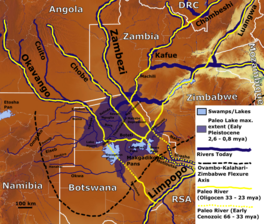Lake Makgadikgadi
| Lake Makgadikgadi | |
|---|---|
 The extent of the former Lake Makgadikgadi. | |
| Location | Kalahari Desert in Botswana |
| Coordinates | 20°43′0″S 24°57′3″E / 20.71667°S 24.95083°E |
| Basin countries | Botswana |
| Average depth | 30 metres (98 ft) |
Lake Makgadikgadi (
Origin and history
Approximately 3 million years ago, strong easterly winds formed long dunes, which ran from east to west across the middle of the Kalahari Desert. During wetter times, these dunes channeled the great rivers of the area, the
Northern Botswana has a series of deep, underlying
Approximately 2 million years ago, the fault known as the Ovamboland-Kalahari-Zimbabwe axis (which runs from NE to SW from
The great Magwikwe Sand Ridge between Savuti and North Gate probably defined one of its northwestern shorelines. Another is thought to have been the less obvious Gidikwe Sand Ridge lying just to the west of the western border of the present Makgadikgadi National Park.
Wave-washed features can be found on several of the Kalahari's higher places in this region. The eastern side of the Ghoha Hills, north of Savuti, is a particularly clear example of this. Round, water-eroded pebbles can also be found.
As the millennia passed, the lake filled to capacity. It began to overflow about 20,000 years ago, taking the lowest point in the
A drier climatic period followed, which increased evaporation and decreased the flow of the rivers that fed the lake. By about 10,000 years ago the drying of Lake Makgadikgadi was in an advanced stage. Sediment and debris from the Okavango River and windblown sand were gradually filling the lake.[5]
The Gumare fault formed and lowered the land. As a result, the water of the Okavango River spread out over a much larger area of land than it previously had, forming the now characteristic fan-shaped inland delta of the Okavango, which further reduced the water that flowed into Lake Makgadikgadi and hastened its demise.
Human origin theory
In October 2019, a team led by
The conclusion is disputed by Chris Stringer, head of human origins at the Natural History Museum in London, and Sarah Tishkoff, a geneticist at the University of Pennsylvania.[8][3]
Excavations of early Homo sapiens activities have been found at Ga-Mohana Hill in Northern Cape dated to 105,000 years ago (105
Ecology
Lake Makgadikgadi is theorised to have been the birthplace of the vast number of
In current times this land is desiccated most of the year and is a seasonal wetland in the rainy summer months.[11]
Legacy
Today the only remains of Lake Makgadikgadi are the
The
The other south draining rivers that once fed the lake have now all been captured by the Zambezi.
References
- ^ "Makgadikgadi Salt Pans". earthobservatory.nasa.gov. 2018-07-06. Retrieved 2018-08-16.
- ^ Michael Irving (October 28, 2019). "DNA study claims human "homeland" was a southern African wetland". New Atlas. Retrieved October 28, 2019.
- ^ S2CID 204946938.
- S2CID 16200741.
- ^ a b c "Geological history - Botswana Travel Guide". www.botswana-travel-guide.com. Retrieved 2018-08-15.
- ^ "Geological history - Botswana Travel Guide". www.botswana-travel-guide.com. Retrieved 2021-04-13.
- ^ Irving, Michael (2019-10-28). "DNA study claims human "homeland" was a southern African wetland". New Atlas. Retrieved 2021-03-01.
- ISSN 0261-3077. Retrieved 2019-10-29.
- S2CID 232483324.
- ^ Owen, James (May 4, 2005). "Lost African Lake Spawned Fish Diversity 'Beyond Belief'". National Geographic News. Archived from the original on May 14, 2005. Alt URL
- ^ Hogan, C. Michael (2008). Burnham, A. (ed.). "Makgadikgadi". The Megalithic Portal.
External links
- "Bushways Safaris article on the Okavango Delta". Archived from the original on May 16, 2008.


